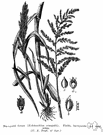ThesaurusAntonymsRelated WordsSynonymsLegend:
| Noun | 1. |  Echinochloa - annual or perennial succulent grasses of warm regions Echinochloa - annual or perennial succulent grasses of warm regionsliliopsid genus, monocot genus - genus of flowering plants having a single cotyledon (embryonic leaf) in the seed family Graminaceae, family Gramineae, family Poaceae, Graminaceae, Gramineae, grass family, Poaceae - the grasses: chiefly herbaceous but some woody plants including cereals; bamboo; reeds; sugar cane barn grass, barn millet, barnyard grass, Echinochloa crusgalli - a coarse annual panic grass; a cosmopolitan weed; occasionally used for hay or grazing billion-dollar grass, Echinochloa frumentacea, Japanese barnyard millet, Japanese millet, sanwa millet - coarse annual grass cultivated in Japan and southeastern Asia for its edible seeds and for forage; important wildlife food in United States |
Based on WordNet 3.0, Farlex clipart collection. © 2003-2012 Princeton University, Farlex Inc.